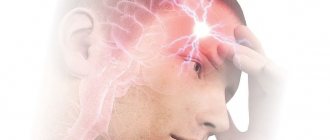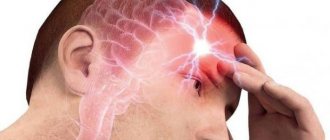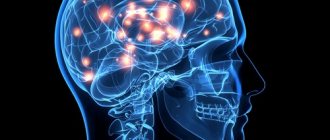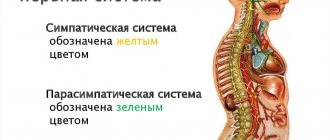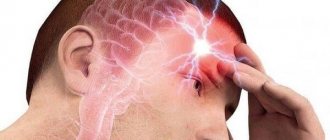Today, the diagnosis of vegetative-vascular dystonia (VSD) is being made less and less often to patients, but not because humanity has been able to completely defeat this disease, but because this formulation is outdated. Vegetative-vascular dystonia means dysfunction of the autonomic nervous system, which is not an independent disease, but is only a consequence of pathological changes in the body.
In the latest edition of ICD-10 there is no such disease as VSD. The disorders characteristic of it are called by the more modern and precise term “somatoform autonomic dysfunction of the nervous system.” But for simplicity of presentation and understanding, we will further use the more familiar concept of VSD.
What is VSD
The autonomic nervous system, also called the autonomic nervous system, is part of the nervous system of the human body. It is responsible for controlling the activity of internal organs, metabolic processes occurring in the body, the functioning of blood and lymphatic vessels, as well as the activity of the endocrine glands. Thus, the autonomic nervous system plays an important role in maintaining homeostasis (constancy of the internal environment) and adaptation to changing environmental conditions.
The autonomic nervous system is responsible for the innervation of the entire body, organs and tissues. Moreover, its work is in no way subordinate to the will of a person, but is controlled independently of desires by the cerebral cortex. That is, a person cannot voluntarily stop the heart or influence the speed of intestinal peristalsis.
Autonomic nerve centers are also located in the brain stem, hypothalamus and spinal cord. Therefore, any disturbances in these organs are directly reflected in the quality of functioning of the autonomic nervous system, and can lead to the development of autonomic disorders.
Thus, all vital processes of the body are under the control of the autonomic nervous system, namely:
- heart rate;
- blood pressure level;
- thermoregulation;
- activity of salivary, sweat, endocrine glands;
- frequency and depth of breathing;
- digestion of food and intestinal motility;
- the condition of the smooth muscles of internal organs and the walls of blood vessels;
- processes of growth and reproduction;
- metabolic processes;
- urination, etc.
Anatomically and functionally, the autonomic nervous system is divided into 3 sections:
- Sympathetic - responsible for metabolism, energy consumption and mobilization of forces for active activity. Its sphere of influence includes heart function and blood pressure levels. Therefore, the sympathetic department allows the human body to prepare as much as possible for fight or active work.
- Parasympathetic - regulates the functioning of organs mainly during sleep and passive rest, and is responsible for restoring spent energy reserves. It is responsible for reducing heart rate, blood pressure and increasing peristalsis, which makes it possible to replenish energy reserves from food received.
- Metasympathetic - ensures communication between internal organs and the preservation of local autonomic reflexes.
All parts of the autonomic nervous system are in a certain relationship with each other, which ensures proper regulation of the body’s functioning. At the same time, the most important organs from the point of view of life support have double innervation with the opposite effect. But when the slightest deviation from the norm occurs, under the influence of stress, the balance between the sympathetic and parasympathetic departments is disrupted, which leads to the predominance of one of them over the other. The result of this is the development of vegetative-vascular dystonia.
Vegetative-vascular dystonia is a syndrome that combines various disorders of autonomic functions that are the result of impaired neurogenic regulation. This occurs when the balance between the activity of the sympathetic and parasympathetic parts of the autonomic nervous system is disturbed, which can be due to the action of a huge variety of the most disparate causes.
Thus, VSD is a multifactorial disorder that can be regarded as one of the symptoms of an existing neurological or somatic disease and consists of changes in the functioning of internal organs. Sometimes the root cause of the development of vegetative-vascular dystonia cannot be established.
Vegetative-vascular dystonia is often also called cardioneurosis, dysvegetosis, neurasthenia and some other terms.
Diagnosis of VSD
First, let's look into the brain and see if there is anything superfluous there that was not provided for by Mother Nature - i.e. We will do a computed tomography (CT) or nuclear magnetic resonance (MRI) scan. We looked and didn’t really find anything, and thank God! Our next step - we propose to look at the vessels of the head not as a whole (REG), but in particular - to do Dopplerography of the vessels of the head and neck, where it is clearly visible where, in what area the problem lives. We know and remember that blood vessels are one of the components of our brain; these are the highways that carry nutrients to brain cells that, alas, cannot eat themselves. Many experts argue that it is enough to look at the vessels using Magnetime (magnetic nuclear resonance), yes, of course you can, this is to roughly photograph the water in the river, and then guess at what speed it is moving and whether it is moving at all. And our vessels are the same rivers, the blood in them moves constantly while we breathe and live...
Causes of vegetative-vascular dystonia
VSD can develop against the backdrop of a huge number of diverse factors. Among them are especially distinguished:
- psychological – severe or constant stress, depressive states;
- physical – severe physical fatigue, exposure to vibration, high temperatures, sunstroke;
- chemical – addiction to alcohol, nicotine, narcotic substances, taking a number of medications, in particular those containing ephedrine, caffeine, bronchodilators;
- changes in hormonal levels - adolescence, pregnancy and lactation, menopause, use of hormonal contraceptives, especially with frequent periods of withdrawal;
- infectious – acute and chronic diseases of the respiratory system, kidneys, brain;
- neurological disorders - Parkinson's disease, traumatic brain injury;
- endocrine diseases – diabetes mellitus, thyrotoxicosis;
- pathologies of the cardiovascular system - arterial hypertension, coronary artery disease.
It is believed that the main cause of the development of VSD is stress.
But not all people who have even several of the listed diseases develop vegetative-vascular dystonia. Women suffer from it 2 times more often than men, and almost half of all cases of VSD diagnosis occur in young girls who have not yet turned 25 years old. And only 33% of women with vegetative-vascular dystonia are over 25 years old.
Heredity plays a significant role in assessing the risk of VSD. Very often it first appears in childhood or adolescence. As one gets older, the disorder can be compensated and the attacks disappear. But the impact of negative factors can reverse the situation and again provoke the occurrence of vegetative-vascular dystonia.
The impetus for its development can be:
- psychological characteristics of the individual, especially suspiciousness and a tendency towards hypochondria;
- unfavorable socio-economic, environmental conditions (lack of sunlight, sedentary lifestyle, lack of funds, lack of nutritional culture, consumption of cheap, low-quality products, etc.);
- intrauterine pathologies - infections, hypoxia, fetoplacental insufficiency, rhesus conflict, etc.
Sometimes VSD is a transient reaction to any strong emotional shocks or emergency situations.
Neurocirculatory dystonia: what is it?
This condition is one of the most common reasons for visiting a cardiologist and neurologist.
At different ages, from a third to a half of all registered pathologies of the cardiovascular system are precisely neurocirculatory dystonia. It has been noted that most often it occurs in young and middle age, from adolescence to 45 years. There are also gender differences - in women the disease is registered much more often. Neurocirculatory dystonia in children most often develops in adolescence during puberty, when the body is rebuilt and all regulatory processes, including the functions of the cardiovascular system, undergo significant changes. Psycho-emotional stress, which often accompanies puberty, also plays an important role. Pathogenesis of neurocirculatory dystonia
The essence of neurocirculatory dystonia is a violation of control of the cardiovascular system by the nervous and endocrine systems. It is neurohumoral control that ensures homeostasis by maintaining balance in the sympathetic-adrenal, cholinergic, histamine-serotonin and other systems that regulate numerous vital processes of the human body. In case of failures in the complex regulatory system, which can be caused by a variety of influences, the interaction of the hypothalamic-pituitary system and peripheral endocrine glands is disrupted, the acid-base state of biological media, and all types of metabolism change. The myocardium is very sensitive to these changes, therefore it reacts with changes in contractile function, and vascular tone also changes. A stable response to the action of various factors is gradually formed - a symptom complex of neurocirculatory dystonia of a certain type, appearing in certain circumstances.
Types of neurocirculatory dystonia
The classification of neurocirculatory dystonia is based on the leading symptom of the disease. There are 4 main types:
- Neurocirculatory dystonia of the cardiac type (disturbance of the heart comes to the fore).
- Neurocirculatory dystonia of the hypotonic type develops when the balance shifts towards the parasympathetic nervous system (vagotonia). The main symptom is a decrease in blood pressure (BP).
- Neurocirculatory dystonia of the hypertensive type is a predominance of the sympathetic nervous system (BP increases).
- Neurocirculatory dystonia of a mixed type (changes in blood pressure in one direction or another are combined with disturbances in the functioning of the heart).
In practical medicine, a classification of neurocirculatory dystonia according to severity is used. There are: mild, moderate and severe degrees.
Symptoms of vegetative-vascular dystonia
Thus, it is already clear that vegetative-vascular dystonia can manifest itself in radically different ways. This concept “protects” various symptoms that arise in response to disturbances in the functioning of the autonomic nervous system.
In most cases, VSD occurs latently. But under the influence of overload or other unfavorable factors, an attack develops. Often they arise suddenly and unsettle a person. They are most difficult for older people, since they usually already have a number of other diseases, which aggravates the situation.
Often there are signs of other diseases that are not directly related to the autonomic nervous system or brain. But if manifestations of disturbances in the functioning of the cardiovascular system are observed, the neurologist has good reason to assume the presence of VSD.
The most common complaints of patients who are subsequently diagnosed with vegetative-vascular dystonia are:
- headaches of varying degrees of intensity and duration, migraines;
- attacks of dizziness;
- increased sweating;
- increased heart rate;
- severe weakness, increased fatigue;
- fluctuations in body temperature;
- noise in ears;
- darkening of the eyes, sometimes followed by fainting;
- constant drowsiness;
- increased anxiety, panic attacks;
- sudden mood swings;
- obsessive syndromes, hypochondria.
A panic attack is a strong fear of imminent death that completely grips the patient. The attack begins with the onset of anxiety, which gradually increases and turns into genuine horror. This is explained by the fact that the body sends signals of danger, but does not see options for exiting the situation. The attack lasts on average 10–15 minutes, after which the patient’s well-being gradually returns to normal.
Causes of VSD
So as not to burden you, dear reader, with anatomical details, let’s just say that all the arteries of the neck carry blood (nutrients) to the head. The bulk of these arteries (carotid) pass through the muscular thickness of the neck and virtually nothing can interfere with them (except for atherosclerosis in older people). And, here, the vertebral arteries pass directly into the cervical vertebrae themselves and, since their diameter is normally 3-4 mm, i.e. comparable to the diameter of a ballpoint pen, then any, even minor, problem in the cervical spine leads to such unpleasant phenomena as vertebral artery syndrome. What's going on? We sit for a long time and a lot on our phones, tablets, at work, in the car, we become overgrown with salts (osteochondrosis), we move little (disk malnutrition), we get carried away with manual therapy (vertebral displacement), perhaps we often lift heavy objects (herniated disks), i.e. That is, we have a problem in the cervical spine, which sooner or later will make itself felt, and, as a rule, the pain is not in the neck itself, but in the head. And this problem is purely mechanical - a violation of blood flow through the vital vertebral arteries . A disruption in the power supply of the brain - the main database, one might say, of our system unit - can lead to any problem, to the breakdown of any microcircuit, i.e. not only headaches, intracranial pressure , but also “freezing of any program.”
In children , this manifests itself as follows: obsessive movement syndrome ( nervous tics ), epileptiform syndrome, headaches, intracranial pressure, absent-mindedness, poor memory, inability to learn the required amount of material at school, inadequate vision loss (when ophthalmologists shrug their shoulders and prescribe new ones). , more powerful glasses), panic attacks. In adults : depression, insomnia, headaches, nausea, dizziness, unsteadiness when walking, increased irritability, surges in blood pressure, palpitations (tachycardia), so-called “micro-stroke”, hearing loss, noise, ringing in the ears, feeling of lack of air, coma sore throat, panic attacks. Now let’s take a closer look at exactly what problems in the cervical spine can lead to such unpleasant conditions. First of all, this
- osteochondrosis,
- scoliosis,
- disc herniation,
- discopathy (disc destruction),
- vertebral instability (tumbler vertebrae),
- displacement (listhesis),
- uncovertebral arthrosis.
Types of VSD
The nature of the manifestation of signs of VSD directly depends on the condition of the blood vessels. Based on this, the following types of vegetative-vascular dystonia are distinguished:
- hypertensive;
- hypotonic;
- mixed;
- cardiac;
- vagotonic.
But symptoms are extremely rarely present all the time. Most often they are in the nature of attacks. Not all of the signs characteristic of a particular type of vegetative-vascular dystonia always appear. Moreover, this is rare. Typically, patients complain of 2-3 disorders, the presence of which, in combination with the results of the examinations, makes it possible to determine the specific type of vegetative-vascular dystonia.
Based on how VSD occurs, there are 3 degrees of severity of the disorder:
- mild – patients fully retain their ability to work, symptoms of VSD do not cause them significant discomfort, and there are no vegetative crises;
- moderately severe – periods periodically occur during which a person loses ability to work due to exacerbation of vegetative-vascular dystonia and the development of a vegetative crisis;
- severe - a long, persistent course of VSD with frequent periods of exacerbation and crises, which leads to a significant decrease in performance.
Hypertensive type
Patients experience pronounced vascular tone, as well as a persistent increase in blood pressure. Their main complaints focus on the occurrence of:
- rapid heartbeat;
- hot flashes;
- headaches;
- constant fatigue;
- nausea, vomiting, attacks of which are not associated with eating;
- decrease in appetite up to its complete loss;
- sweating (during an attack there is severe sweating of the palms);
- causeless but strong fear;
- flickering “flies” before the eyes.
Hypotonic type
Characterized by low blood vessel tone and low blood pressure. Therefore, patients are often annoyed by:
- episodes of darkening of the eyes;
- a sharp decrease in blood pressure;
- severe weakness;
- loss of consciousness;
- pale skin;
- nausea, heartburn;
- changes in bowel habits (diarrhea or constipation);
- inability to take a full breath.
It can be noted that in patients with VSD of the hypotonic type, the palms and feet are constantly cold.
Mixed type
With this variant of VSD, variability in vascular tone is observed, so blood pressure can fluctuate within a fairly wide range. It can rise sharply to high levels and then suddenly drop to extreme levels.
In such cases, there is a change in the symptoms of VSD, which occurs according to the hypertensive type, with manifestations of VSD of the hypotonic type. This significantly affects the lives of patients, as attacks of weakness, profuse sweating and fainting states are replaced by hot flashes, tachycardia and headaches.
During an attack, there is often a fear of imminent death and the inability to take a full breath, which further aggravates the situation. Pain in the heart area may be present.
Cardiac type
This type of VSD is diagnosed when aching, throbbing pain occurs in the heart area, which does not have a significant effect on a person’s general well-being. They may be accompanied by arrhythmia and profuse sweating, but the examinations carried out do not reveal heart pathologies.
Vagotonic type
For this type of vegetative-vascular dystonia, the occurrence of breathing disorders is typical. Patients often complain of the inability to take a full breath and a feeling of tightness in the chest. In this case, there may be a tendency to lower blood pressure and slow heartbeat. But with the vagotonic type of VSD, there is an increase in salivation and changes in the functioning of the organs of the digestive system.
Symptoms of VSD
Let's start with, perhaps, the most common - headache , which occurs sporadically or comes quite often. This is dizziness, this is the syndrome of a stale, “heavy head”, this is unsteadiness when walking, this is intracranial pressure accompanied by nausea and vomiting, which do not bring relief, these are psycho-emotional disorders when aggression changes to apathy and vice versa (absolutely groundless), apathy, syndrome chronic fatigue, obsessive fears, negative thoughts that cannot be gotten rid of. This is a memory, vision, hearing, sleep disorder. Blood pressure surges, tachycardia (fast pulse). Or maybe a couple of symptoms from the above, or all at once with sweating and trembling of the whole body...
How does an attack go?
During an attack of VSD, a sympathoadrenal crisis is observed, as a large amount of adrenaline is suddenly released into the blood. Then it starts suddenly. At the same time, you begin to feel your heartbeat, your blood pressure and body temperature rise. In this case, the skin may turn pale and chills may occur. This is accompanied by the appearance of strong fear for one’s own life. This condition lasts on average 20–30 minutes, but can last 2–3 hours, after which the condition gradually improves.
Attacks may occur several times a week or several times a day.
After the attack ends, the patient feels a strong urge to urinate, during which a large volume of light-colored urine is released. Fear is replaced by severe weakness, as there is often a sharp decrease in blood pressure. In some cases, this is accompanied by tremors in the legs, up to the inability to walk normally.
After an attack, people tend to become anxious and fear new episodes. Therefore, depression often occurs, which makes the situation even worse. Also, patients with VSD may tend to refuse to communicate with other people because they are ashamed of their illness and its manifestations. But at the same time, they are also afraid of not receiving much-needed medical care at the right time, which also does not help improve the situation.
Also, an attack of VSD can occur with a vagoinsular crisis. In this case, the attack begins with the appearance of pre-syncope symptoms:
- noise in ears;
- darkening of the eyes;
- sudden weakness;
- a feeling of unreality of what is happening.
These phenomena are observed for a very short period of time, and are replaced by loss of consciousness.
During a vagoinsular crisis, severe abdominal pain and a powerful, urgent desire to empty the intestines may occur. During an attack, accelerated intestinal motility, decreased blood pressure, slowed heart rate and severe sweating are observed. Patients usually complain of cold sweat with a pronounced feeling of heat. They are often overcome by indescribable melancholy and strong fear appears.
Very rarely, an attack of VSD occurs of a mixed type, in which symptoms typical of a vagoinsular and sympathoadrenal crisis are observed. Most often in such cases it is observed:
- shortness of breath, up to a feeling of suffocation;
- chest pain;
- increased heart rate;
- severe dizziness;
- unsteady gait;
- very strong fear of death;
- a feeling of unreality of what is happening.
Symptoms of vegetative-vascular dystonia
In patients of different ages and genders, the disease can manifest itself in completely different ways. However, certain common features can still be identified.
Thus, common symptoms of VSD include the following:
- fast fatiguability;
- lack of air, shortness of breath, suffocation;
- difficulty or rapid breathing;
- feeling of tightness in the chest, pain in the heart;
- rapid heartbeat, arrhythmia;
- decreased appetite;
- nausea, heartburn, flatulence and other gastrointestinal problems;
- frequent urination;
- increased sweating;
- chills, coldness in the extremities, numbness;
- change in skin color (blueness, pallor, redness);
- anxiety, restlessness;
- restless sleep;
- weather sensitivity, etc.
Such manifestations not only have a detrimental effect on the emotional and physical state of patients. Finding yourself with several symptoms from this list gives good reason to visit a doctor. In addition to vegetative-vascular dystonia, the listed signs may indicate organic and cardiovascular pathology, hypertension, chronic coronary heart disease, bronchial asthma, anemia, allergies, and endocrine disorders.
Diagnostics
To diagnose and prescribe treatment for VSD, you must consult a neurologist. Before the consultation, it is best to make a detailed list of complaints. This will help the specialist not only detect VSD, but also suggest what caused its development. The doctor will definitely conduct a thorough survey, during which he will also find out the presence and nature of the prerequisites for the development of vegetative-vascular dystonia.
Then the neurologist proceeds to the examination. The doctor assesses the condition of the skin, measures the pulse, blood pressure, sometimes using an orthostatic test (2 measurements are taken: one in a lying position, the second after taking up a vertical position), listens to the lungs and heart. To assess the activity of the sympathetic and parasympathetic autonomic nervous system, he may pass the end of the hammer handle over the skin.
After completing the examination and assuming the presence of VSD, the neurologist must prescribe a set of studies that will help detect or confirm existing assumptions about the causes of the development of the disorder. For this purpose, patients are prescribed:
- UAC and OAM;
- blood sugar test;
- blood test for TSH, T3 and T4 (thyroid hormones);
- biochemical blood test to determine the concentration of potassium, cholesterol, creatinine, urea and other compounds;
- ECG;
- fluorography of the chest organs;
- rheoencephalography;
- MRI;
- Ultrasound scanning of neck vessels;
- EEG.
In our clinic, you can also learn in more detail about the composition of your body and the state of the vascular system, which is involved in the blood supply to internal organs, skeletal muscles, and the brain. Our experienced doctors will explain the data obtained to you in detail. Bioimpendansometry calculates the ratio of fat, muscle, bone and skeletal mass, total fluid in the body, and basal metabolic rate. The intensity of recommended physical activity depends on the state of muscle mass. Metabolic processes, in turn, affect the body's ability to recover. Based on the indicators of active cell mass, one can judge the level of physical activity and nutritional balance. This simple and quick test helps us identify disturbances in the endocrine system and take the necessary measures. In addition, it is also very important for us to know the condition of blood vessels for the prevention of diseases such as heart attacks, hypertension, heart failure, diabetes and much more. Angioscan allows you to determine such important indicators as the biological age of blood vessels, their stiffness, stress index (which indicates heart rate), and blood oxygen saturation. Such screening will be useful for men and women over 30, athletes, those undergoing long-term and severe treatment, as well as everyone who monitors their health.
Treatment of vegetative-vascular dystonia
Treatment of VSD is always selected strictly individually. In this case, the neurologist must take into account a lot of factors and formulate the optimal tactics. Not only the type of vegetative-vascular dystonia, the severity and frequency of attacks, the patient’s age, but also the presence of concomitant diseases and their characteristics are taken into account.
When prescribing treatment for patients with VSD, neurologists pursue two goals: eliminating the symptoms of vegetative-vascular dystonia and influencing the cause of the development of dysfunction of the autonomic nervous system. The second task is of particular importance, since sometimes it is not possible to find the true cause of VSD. But the patient’s quality of life in the future primarily depends on this, since by eliminating the cause of VSD, the cause itself will also be eliminated. Therefore, treatment of vegetative-vascular dystonia is often carried out not only by a neurologist, but also by other specialized specialists, in particular, a cardiologist.
Also, treatment of vegetative-vascular dystonia involves influencing the psycho-emotional state of patients, since stress and prolonged nervous tension definitely do not improve their condition.
Thus, the treatment of vegetative-vascular dystonia is always complex. It includes:
- drug therapy;
- lifestyle correction;
- psychotherapy;
- Spa treatment.
To combat the causes of VSD, manual therapy is often used. This is due to the fact that a competent effect on the spine can improve the performance of almost every organ of the human body. After all, it is in the spinal cord that the autonomic centers are located, which suffer greatly in the presence of spinal pathologies.
Therefore, the elimination of scoliosis, protrusions, herniated intervertebral discs, spondylosis and other disorders necessarily leads to a significant improvement in the condition of patients, and when treated in the early stages, a complete elimination of the causes of the development of VSD.
One of the most effective methods of manual therapy is the original Gritsenko method. With its help, you can restore the normal position of each vertebra and thereby completely normalize the functioning of the spinal cord. As a result, blood circulation also improves, back and chest pain, breathing problems, and a host of other disorders go away. An additional “bonus” is an increase in the body’s adaptive capabilities and a slowdown in the natural aging process.
When manual therapy is performed correctly, improvements are observed after the first sessions. But to consolidate the results and eliminate the causes of vegetative-vascular dystonia, you need to undergo a course of manual therapy. Moreover, sessions can be combined with work, study, business trips and other activities.
Drug therapy
Treatment of VSD involves the use of a whole range of medications, the list of which, as well as the dosage, is determined by the neurologist on an individual basis. Thus, drug therapy for vegetative-vascular dystonia may include:
- Antidepressants help eliminate excessive anxiety, increased irritability and help overcome depression, psycho-emotional stress, and apathy. Often, while taking antidepressants, there is a decrease in heart pain and muscle pain, even in cases where they previously could not be relieved by other means.
- Tranquilizers - used to reduce the risk of panic attacks, eliminate causeless fears and relieve increased anxiety.
- Sedatives - initially preference is given to herbal remedies, but if they do not have the desired effect, they are replaced with “heavy artillery”. Herbal remedies act gently; in the absence of allergies, they do not have a negative effect on the body, but have a beneficial effect on the nervous system.
- Nootropics are designed to activate blood circulation in the vessels of the brain, remove the negative effects of hypoxia (oxygen deficiency) and increase the body’s ability to resist stress.
- Adrenergic blockers are prescribed when problems with the heart are detected.
- Diuretics - used in the presence of headaches, attacks of dizziness that occur against the background of increased intracranial pressure or arterial hypertension. They help remove excess fluid from the body, but lead to a decrease in sodium levels, and some potassium levels. This can negatively affect the functioning of the heart, so diuretics are often combined with drugs that replenish the deficiency of these ions.
- Vitamin preparations containing B vitamins improve the conductivity of nerve impulses and generally have a positive effect on the state of the nervous system as a whole.
- Metabolic drugs - designed to increase control over glucose levels, have microcircular, antihypoxic properties.
Lifestyle correction
In order to improve the functioning of the autonomic nervous system, patients with VSD are recommended to reconsider their lifestyle and habits. Thus, neurologists recommend to all patients:
- Organize the correct work and rest schedule. During the workday, it is important to take breaks, leave your chair and go for a walk to improve blood flow in the body and give your head a chance to rest.
- Get enough sleep. It is recommended to sleep at least 8 hours every day.
- Walk outdoors every day. It's worth walking for about an hour. This is enough to improve the functioning of the entire body.
- Make moderate physical activity an integral part of your life. Fanatical exercise with VSD will be detrimental, but half an hour of jogging, aerobics, and swimming will be very helpful.
- Eat properly. Patients are advised to avoid foods with a high content of trans fats, which contribute to the formation of atherosclerotic plaques and also increase nervous excitability. But a strict diet for VSD is not indicated, since strict restrictions can negatively affect the psycho-emotional state of the patient, which will aggravate the course of vegetative-vascular dystonia.
Since the topic of nutrition in VSD raises many questions, it requires a more detailed consideration. With such a diagnosis, the diet should be built in accordance with the following principles:
- enriching the diet with foods that are sources of potassium and magnesium and have a positive effect on the functioning of the cardiovascular system, in particular blood pressure levels;
- normalization of water-salt balance by drinking 1.5 liters of water per day, in addition to tea, juices and other drinks;
- enjoying food;
- bringing the diet as close as possible to the requirements of a healthy diet.
The nature of the diet may vary depending on the type of vegetative-vascular dystonia. So, in case of hypertensive form, it is important to exclude foods containing large amounts of “hidden” salt. For this purpose, it is recommended to refrain from eating fast food, canned food, marinades, semi-finished products, etc. Instead, patients are asked to include soups with vegetable or weak meat or fish broth in their daily menu. It is also recommended to replace traditional wheat or rye bread with products made from whole grain flour or with bran.
With hypotonic VSD, when creating a menu, you should pay special attention to vegetables and fruits that contain increased amounts of well-absorbed vitamin C and β-carotene, as well as foods that increase blood pressure. Thus, with this form of dysfunction of the autonomic nervous system, it is worth introducing into the daily diet:
- citrus fruits, bananas, bell peppers, pineapples, pomegranate;
- any nuts, buckwheat, liver, brains;
- cheeses;
- herring;
- dark chocolate, cocoa, coffee.
With hypotonic VSD, it is not prohibited to eat white bread, potatoes and even sweets.
If a patient is diagnosed with a cardiac form of the disease, he is recommended to bring foods that are a source of magnesium and potassium to his table. This will have a positive effect on the functioning of the heart muscle and reduce the risk of developing dangerous complications. Therefore, they should pay attention to:
- oatmeal, buckwheat;
- legumes;
- onions, eggplants;
- apricots, peaches, grapes, including in the form of dried fruits;
- natural juices, compotes, jelly;
- dairy products;
- chicken eggs;
- lean varieties of fish and meat.
Psychotherapy
With vegetative-vascular dystonia, it is important not to close yourself off from the problem, but to solve it. Therefore, competent psychotherapy plays a significant role in the treatment of VSD. Psychotherapy helps you understand yourself better, become calmer and more confident.
Spa treatment
An annual holiday in a sanatorium outside the period of exacerbation of vegetative-vascular dystonia has a positive effect on the physical and psycho-emotional state of people, which helps to prolong remission. But with VSD, long trips abroad will not be the best idea. It would be more correct to choose a balneological resort in the climatic zone in which he permanently lives, since a sharp change in climate can negatively affect a person’s condition and provoke a new exacerbation of VSD.
Neurocirculatory dystonia: current issues of diagnosis and treatment
Neurocirculatory dystonia (NCD) is a disease that belongs to the functional group and is manifested by cardiovascular, respiratory and autonomic disorders, asthenia, poor tolerance to stress and physical activity. The disease progresses in waves, with periods of exacerbations and remissions, and has a favorable prognosis, since it does not develop congestive heart failure and life-threatening cardiac arrhythmias.
Data on the incidence of NCD are conflicting. In medical practice, the disease is diagnosed in a third of people examined for cardiovascular complaints. Young women are more often affected.
Etiology and pathogenesis
Among the predisposing factors, hereditary and constitutional characteristics, personality traits, periods of hormonal changes (dyzovarial disorders, abortion, pregnancy, menopause), and lifestyle are important. Factors causing the disease: psychogenic (neuro-emotional stress, unfavorable socio-economic conditions), physical and chemical influences (insolation, hot climate, vibration), chronic intoxication, including alcohol and tobacco, infections of the upper respiratory tract and nasopharynx , physical inactivity, mental and physical fatigue.
The interaction of these factors leads to disruption of neurohormonal-metabolic regulation. The leading link appears to be damage to the hypothalamic structures that play an integrative role. Dysregulation manifests itself in the form of dysfunction of the sympathoadrenal and cholinergic systems, changes in the sensitivity of peripheral receptors, when a hyperactive response is noted to the usual secretion of catecholamines. The functions of the histamine-serotonin and kallikreinin systems and water-electrolyte metabolism are disrupted. Microcirculation processes are inhibited, which leads to tissue hypoxia.
A disorder of the neurohormonal regulation of the heart leads to an incorrect response to stimuli, which is expressed in inappropriate tachycardia, fluctuations in vascular tone (increased or decreased blood pressure), an increase in cardiac output (hyperkinetic type of blood circulation), spasms of peripheral vessels.
Classification
There is a working classification by V.I. Makolkin and S.A. Abbakumov.
- Etiological forms:
– essential (constitutional-hereditary); – psychogenic (neurotic); – infectious-toxic; – associated with physical stress; – caused by physical and professional factors.
- Clinical syndromes:
– cardialgic; – tachycardial; – hypertensive; – hypotonic; – peripheral vascular disorders; – vegetative crises; – respiratory; – asthenic; – myocardial dystrophy.
- Severity:
– light; – average; – heavy.
Diagnostics
Manifestations of the disease are polymorphic, the severity of symptoms is variable. In some cases, they resemble signs of other cardiovascular diseases, which can make it difficult to recognize NCD.
- Pain in the heart area (aching, stabbing) is noted. Their duration varies: from instant (“piercing”) to monotonous, lasting for hours and days. The pain is localized in the area of the apex of the heart, less often - just below the left subclavian region or parasternally. Migration of pain is noted. The occurrence of pain is associated with overwork, anxiety, weather changes, and alcohol intake. In women, pain sometimes occurs during the premenstrual period. Pain can also occur during vegetative paroxysms (crises), accompanied by palpitations and increased blood pressure (BP), usually accompanied by a feeling of anxiety and decreased mood. Paroxysmal intense pain is accompanied by fear and vegetative disorders in the form of a feeling of lack of air, sweating, and a feeling of internal trembling. Patients willingly take tincture of valerian or hawthorn. Taking nitroglycerin does not relieve pain.
- Some patients complain of rapid shallow breathing, a feeling of incompleteness of inspiration, and a desire to inhale deeply (“sad sigh”). There may be a feeling of a “lump” in the throat or squeezing it. It is difficult for the patient to be in a stuffy room; there is a need to open the windows. These phenomena are accompanied by a feeling of anxiety, dizziness, and fear of suffocation. This syndrome can be interpreted as a manifestation of respiratory or heart failure.
- Patients note palpitations, sensations of increased heart activity, accompanied by a feeling of pulsation of the vessels of the neck and head, appearing at the moment of exertion or excitement, and sometimes at night, from which the patient wakes up. Palpitations are provoked by excitement, physical activity, and alcohol intake.
- Asthenic syndrome is expressed in decreased performance, a feeling of weakness, and increased fatigue.
- Peripheral vascular disorders are manifested by headaches, “flickering spots” before the eyes, dizziness, and a feeling of coldness in the extremities.
- Patients may report fluctuations in blood pressure (decrease or increase, usually not exceeding 160–170/90–95 mmHg). In addition, periods of elevated blood pressure are short-lived.
- Some patients report an increase in body temperature to 37.2–37.5°C, differences in temperature in the right and left armpits, and a decrease in the temperature of the skin of the extremities (“icy hands”).
- Vegetative crises are manifested by trembling, chills, dizziness, sweating, a feeling of lack of air, and unaccountable fear. Such conditions usually occur at night, last from 20–30 minutes to 2–3 hours and often end with excessive urination or loose stools. Such conditions usually resolve on their own or with medications (sedatives, beta-blockers). Over time, the severity of symptoms decreases, crises appear less frequently and may disappear completely.
The severity of the course is determined by a combination of various parameters: the severity of tachycardia, the frequency of vegetative-vascular crises, pain, and tolerance to physical activity.
Physical examination
Many signs of cardiovascular and autonomic disorders are revealed, but they are not very specific. Some patients resemble those suffering from hyperthyroidism (brilliant eyes, anxiety, tremors), others, on the contrary, are sad, with dull eyes, and adynamic. Increased sweating of the palms, legs, and armpits is also common. Hyperemia of the face, skin, chest, easily occurring dermographism or even “nervous” urticaria are detected in many patients at the first examination; unmotivated and very lively “play of the pupils” is often encountered. The high reactivity of the vascular system is evidenced by persistent dermographism. The limbs are cold, sometimes pale, bluish. Frequent, shallow breathing is noted, patients predominantly breathe through the mouth (and therefore the mucous membranes of the upper respiratory tract often dry out). Many patients cannot make a forced exhalation. In some patients, increased pulsation of the carotid arteries is detected as a manifestation of a hyperkinetic state of blood circulation.
By palpation in the precordial region, especially in the III–IV intercostal space along the midclavicular line and on the left parasternally, areas of pain in the intercostal muscles are determined (in 50% of cases), usually during periods of exacerbation of the disease. When auscultating the heart, an additional sound in systole is often heard at the left edge of the sternum and at the base of the heart (at its beginning - an ejection sound, and at the end - a systolic click).
The most common auscultatory sign is systolic murmur (approximately 70% of cases). This noise is very typical - weak or moderate, with a large area of sound from the apex of the heart to the base (maximum sound in the III-IV intercostal space at the left edge of the sternum).
A feature of the pulse in people with NCD is its lability: the ease of tachycardia occurring with minor emotions and physical effort. Tachycardia often occurs during an orthostatic test or increased breathing. In many patients, the difference in pulse in clino- and orthostasis can be 100–200% of the original one. The pulse rate in people with NCD reaches 120–130 beats/min. Episodes of supraventricular tachycardia and paroxysms of atrial fibrillation are rare.
Blood pressure is labile, so it is better not to rely on the results of a single measurement. Often the first measurement shows a slight excess of the upper limit of normal, but after 2–3 minutes the pressure returns to normal limits. Asymmetry of blood pressure on the right and left extremities can be determined. On palpation of the abdomen, in 1/3 of cases, mild diffuse pain is noted in the epigastrium or around the navel.
Treatment
1. Etiological treatment
It is necessary to eliminate the impact of stressful situations (normalize family relationships, eliminate conflict situations at work). In the infectious-toxic form of NCD, an important role belongs to the sanitation of the oral cavity, treatment of foci of chronic infection, and timely tonsillectomy. In case of NCD caused by physical and professional factors, it is necessary to exclude occupational hazards, and in some cases - rational employment.
2. Rational psychotherapy, auto-training
Often it can be much more effective than drug treatment. The doctor must explain to the patient the essence of the disease, emphasize its benign nature, favorable prognosis and the possibility of recovery. In some cases, it is advisable to conduct psychotherapy in the presence of the patient’s relatives in order to inform them about the essence of the disease and the possibility of its cure. The patient should be taught self-hypnosis formulas to reduce the unpleasant subjective manifestations of the disease. Self-hypnosis should be combined with auto-training and muscle relaxation.
3. Normalization of disturbed functional relationships of the limbic zone of the brain, hypothalamus and internal organs
3.1. Use of sedatives
Valerian and motherwort herb have not only a calming effect, but also a “stem” effect, that is, they normalize the function of the brain stem and hypothalamus. Valerian root or motherwort herb is taken in the form of infusions (10 g per 200 ml of water) 1/4 cup 3 times a day and at night for 3-4 weeks.
3.2. Treatment with tranquilizers
Tranquilizers have anxiolytic properties, relieve feelings of fear, anxiety, and emotional tension. Elenium is prescribed at 0.005–0.01 g 2–3 times a day. Diazepam (Seduxen, Relanium) - prescribed in a dose of 2.5-5 mg 2-3 times a day, with a pronounced feeling of fear, the single dose can be increased to 10 mg; the drug reduces the frequency of sympathoadrenal crises. Phenazepam is a highly active tranquilizing drug, it is recommended to take 0.5 mg 2-3 times a day. Oxazepam (Nozepam, Tazepam) - taken 0.01 g 2-3 times a day. Medazepam (Mezapam, Rudotel) - taken 0.01 g 2-3 times a day. Tofisopam (Grandaxin) is a daily tranquilizer, used 0.05–0.1 g 2–3 times a day. Tranquilizers are taken for 2–3 weeks; they are especially indicated before stressful situations. In recent years, drugs such as Afobazole (a daytime over-the-counter tranquilizer that does not cause drowsiness) and Tenoten (a homeopathic drug containing microdoses of antibodies to the brain protein S-100) have begun to be used.
3.3. Combined drugs "Belloid" and "Bellaspon"
They reduce the excitability of adrenergic and cholinergic structures and have a calming effect on the hypothalamic area of the brain. They are a kind of “vegetative correctors”, normalizing the function of the autonomic nervous system. Belloid - 1 tablet of the drug contains 30 mg of butobarbital, 0.1 mg of belladona alkaloids, 0.3 mg of ergotoxin. Prescribed 1 tablet 2-3 times a day. Bellaspon (Bellataminal) - 1 tablet contains 20 mg of phenobarbital, 0.3 mg of ergotamine, 0.1 mg of belladonna alkaloids. Prescribed 1-2 tablets 2-3 times a day.
3.4. Antidepressants
They are indicated primarily for depression. Masked depression is possible, when the depression itself is “masked” by various somatoneurological disorders. Such masked (primary) depression should be distinguished from secondary depression in NCD. The use of antidepressants should be differentiated. In the case of anxious, agitated depression, amitriptyline (Triptisol) 50–75 mg/day is indicated; for asthenic forms of depression - imipramine (Imizin, Melipramine) 50–100 mg/day. For severe hypochondriacal symptoms, Teralen 20–40 mg/day and Sonapax 30–50 mg/day are prescribed. For mild depression, Azafen can be used at a dose of 0.075–0.125 g per day. More modern drugs include citalopram (Cipramil), fluoxetine (Prozac), paroxetine (Rexetine), pirlindole (Pyrazidol). Doses of antidepressants should be “titrated”, starting with small ones (1/2 tablet per dose) and gradually increasing to optimal ones. Treatment lasts about 4–6 weeks. As depression improves, the antidepressant dose is reduced.
3.5. Nootropic drugs
They improve energy processes and blood supply to the brain, increase resistance to hypoxia, activate intellectual functions, improve memory, which is especially important for patients with NCD who are engaged in mental activity. Indicated in the presence of signs of adynamia, asthenia, and hypochondriacal disorders. They can be used as adjuncts in the treatment of depressive conditions resistant to antidepressants. Piracetam (Nootropil) - prescribed in capsules or tablets of 0.4 g 3 times a day for 4-8 weeks. If necessary, you can increase the dose to 0.8 g 3 times a day. More modern and powerful means are Phenotropil, Pantocalcin. Picamilon has a mild effect and is well tolerated.
3.6. Cerebroangiocorrectors
They normalize cerebral circulation, which has a positive effect on the functional state of the limbic zone of the brain and hypothalamus. These remedies are especially appropriate for angiodystonic headaches, dizziness, and cervical osteochondrosis.
Cavinton (vinpocetine) - used in tablets of 0.005 g, 1-2 tablets 3 times a day for 1-2 months.
Stugeron (cinnarizine) - prescribed in tablets of 0.025 g, 1-2 tablets 3 times a day for 1-2 months.
Instenon forte - 1 tablet 2 times a day for at least 1 month.
4. Reducing the increased activity of the sympathoadrenal system
Normalization of the tone of the sympathoadrenal system is a pathogenetic method of treating the hypertensive variant of NCD, characterized by high sympathicotonia. For this purpose, beta-blockers are used.
The most commonly used is propranolol (Anaprilin, Inderal, Obzidan) in a daily dose of 40 to 120 mg. The course of treatment with beta-blockers lasts from 2 weeks to 5-6 months, on average 1-2 months. After achieving a therapeutic effect, the dose is reduced by half or three times. During periods of improvement, beta-blockers can be discontinued.
Phytotherapy
It helps normalize the hypothalamic-visceral relationship, the activity of the cardiovascular system, and sleep. The following fees are recommended.
Collection No. 1: chamomile (flowers) 10 g, lily of the valley (flowers) 10 g, fennel (fruits) 20 g, peppermint (leaves) 30 g, valerian (root) 40 g. Pour two teaspoons of crushed collection into 1 tbsp. . water, leave for 3 hours, boil, cool, strain. Take 40 ml (2.5 tablespoons) 5 times a day.
Collection No. 2: motherwort (herb) 20 g, valerian (root) 20 g, calendula (flowers) 20 g, cumin (fruits) 20 g, dill (seeds) 20 g. Pour 1 teaspoon of collection with 1 glass of boiling water, leave for 2 h, strain. Take 1 tablespoon 4-5 times a day.
Collection No. 3: hawthorn (flowers) 20 g, lily of the valley (flowers) 10 g, hops (cones) 10 g, peppermint (leaves) 15 g, fennel (fruits) 15 g, valerian (root) 20 g. 1 tablespoon crushed collection, pour 1 glass of cold boiled water, leave in a cool place for 3 hours, then boil, cool, strain. Take 1/4 cup 4 times a day 20 minutes before meals.
Improvement with herbal medicine occurs after 2–3 weeks, but a lasting effect is achieved only in the case of long-term regular use of herbal infusions (for 6–8 months). After 1–2 months, if you feel well, you can take breaks for 7–10 days, and after the break change the fees. For preventive purposes (even in satisfactory condition), it is recommended to take the mixture for 2 months, 2 times a year - in spring and autumn.
A modern combined herbal medicine with a sedative effect is Persen. It consists of valerian root, peppermint and lemon balm. Rhizomes with valerian roots contain essential oils with monoterpenes, sesquiterpenes and less volatile valeric acids, gamma-aminobutyric acid (GABA), glutamine and arginine, used for increased nervous excitability, have a sedative effect and improve sleep.
Melissa leaves have a calming and carminative effect.
The active ingredients contained in lemon balm leaves are essential oils, monoterpene aldehydes such as geranium oil, neroli oil and cedrate oil, flavonoids, glucosides, monoterpenes, tannins (rosmarinic acid), triterpene acids and bitter substances. Peppermint leaves have an antispasmodic effect on the smooth muscles of the gastrointestinal tract, as well as a choleretic and carminative effect. The main active ingredients found in peppermint leaves include menthol essential oil, flavonoids, phenolic acid and triterpene acid.
Persen is used as a sedative for increased nervous excitability, sleep disorders, insomnia, irritability; feeling of internal tension. Persen is available in two dosage forms - Persen tablets and Persen forte capsules. For adults and adolescents over 12 years of age, the drug is prescribed 2-3 tablets or 1-2 capsules. The drug is taken 2-3 times a day.
For insomnia - 2-3 tablets or 1-2 capsules an hour before bedtime.
For children aged 3 to 12 years, the drug is prescribed only under the supervision of a doctor and only in the form of tablets. The dose depends on the patient’s body weight, on average 1 tablet 1–3 times a day.
The decision on the advisability of using the drug during pregnancy (especially in the first trimester) and lactation (breastfeeding) should be made only after assessing the expected benefit to the mother and the potential risk to the fetus and child.
The duration of treatment is not limited. Even with long-term use of tablets or capsules, there is no dependence.
When Persen is discontinued, withdrawal syndrome does not develop.
When using the drug, the reaction rate may decrease, so taking it before activities that require increased attention is not recommended.
We have experience with a course of using the drug “Persen” for 3 weeks in 16 patients, 10 of whom had cardiac-type NCD, 6 had asthenoneurotic syndrome due to somatic diseases. The age of the patients ranged from 25 to 45 years, among them there were 3 men and 13 women. In the control group (n=10), comparable in gender and age to the main group, an alcoholic tincture of valerian was used, 30 drops 3 times a day.
During the treatment, it was found that in the Persen group, the level of anxiety on the Taylor scale decreased significantly more quickly, the Kerdo autonomic index normalized, the severity of cephalgia and cardialgia on the visual analogue scale (VAS) decreased, and the quality of life (QoL) increased compared to the comparison group .
Physiotherapy, balneotherapy, massage, acupuncture
In order to regulate the central nervous system and reduce the manifestations of cardialgia syndrome and extrasystoles, electrosleep is used. To obtain a calming effect, it is prescribed with a frequency of 10–25 Hz, from 20 to 40 minutes daily, the course of treatment is 15 sessions. For NCD of the hypotonic type, electrosleep is prescribed with a gradually increasing (after 3–4 sessions) pulse frequency (10–40 Hz).
In case of hypertensive syndrome, electrophoresis of 5–10% solution of sodium or potassium bromide, 5% solution of magnesium sulfate, 1% solution of Euphyllin, 2% solution of papaverine, 1% solution of Dibazol, Anaprilin (40 mg per procedure) is performed using the general effect method or the collar method methodology.
For hypotension, caffeine electrophoresis can be used. Procedures lasting 10–20 minutes are carried out at a current strength of 5–7 mA, every other day. The course of treatment is 15 procedures. For severe asthenia, a galvanic collar according to Shcherbak is used, the duration of the procedure is 10–20 minutes, every other day, the course of treatment consists of 15–20 procedures. In case of pronounced manifestations of cardiac syndrome, electrophoresis of a 5–10% solution of Novocaine, 0.5–1% solution of nicotinic acid is recommended, preferably using the general effect method or the cardiac method (electrodes are placed on the heart area and in the interscapular region).
In case of arrhythmic syndrome, electrophoresis of a 5% solution of Novocaine, 2% solution of Panangin or Anaprilin is prescribed according to the cardiac technique. In case of pronounced clinical manifestations of hypothalamic dysfunction and vegetative-vascular paroxysms, intranasal electrophoresis of Relanium can be recommended. The course of treatment is 10 procedures.
Water procedures have a positive effect on patients with NCD. Various showers, douches, dry and wet wraps are used. Valerian, pine, oxygen, nitrogen and pearl baths (temperature 36–37°C) lasting 8–15 minutes have a pronounced sedative effect. Baths are prescribed every other day, the course of treatment is 10–12 baths.
With a sharp predominance of excitation, cardiac and arrhythmic syndromes, hydroprocedures at an indifferent temperature (35–36°C) are indicated; with hypotensive ones, lower temperatures (32–33°C) are indicated. For hypertensive and cardiac types of NCD, radon, hydrogen sulfide, and iodine-bromine baths are recommended; in the hypotensive variant - carbon dioxide, iodine-bromine. The water temperature in all baths is 35–36°C, duration is 8–15 minutes, baths are prescribed every other day, the course of treatment is 10 baths.
With a pronounced predominance of excitation processes, radon and nitrogen baths have the best effect; with asthenia, carbon dioxide baths. Radon and iodine-bromine baths are also advisable for osteochondrosis. If cerebral symptoms predominate, local baths are recommended as a distraction procedure: foot baths (fresh, mustard), water temperature in the bath is 40–42°C, duration is 10–15 minutes. For the same purpose, paraffin applications are prescribed on the feet (paraffin temperature 50–55°C) for 20–30 minutes every other day, a course of 10 procedures.
Aeroionotherapy has become widespread in the treatment of patients with NCD. Aeroionizers are used for individual (“Ovion-S”) and collective use (“Chizhevsky’s chandelier”). In the process of air ionization, air ions are formed with a predominance of air ions of a negative sign. Patients are located at a distance of 70–100 cm from the device, the session lasts 20–30 minutes, during which time the patient inhales air charged with negative ions. The course of treatment is 12–14 sessions. Under the influence of aeroionotherapy, there is a decrease in blood pressure (by 5–20 mm Hg), a decrease in heart rate, an increase in gas exchange, an increase in oxygen consumption, the disappearance of insomnia, a decrease in headaches, and weakness.
Massage has a positive effect on patients with NCD. Patients benefit from a restorative massage; careful massage of the cervical and thoracic spine is recommended for osteochondrosis of these sections. An effective method of treating NCD is acupressure, which can be performed by the patient himself and his relatives.
Acupuncture normalizes the functional state of the central and autonomic nervous system; eliminates vegetative-vascular dystonia; increases the body's adaptive capabilities; improves metabolism and function of internal organs; has an analgesic effect, relieves cephalgia and cardialgia; normalizes blood pressure. Acupuncture can be carried out using the classical method or in the form of electroacupuncture. Usually the inhibitory version of IRT is used with a gradual increase in the number of points. The first course includes 10 sessions, after a 2-week break the second course is prescribed and after 1.5 months - the third course.
In acupuncture, to restore the functions of the central nervous system, relieve emotional stress, and obtain a sedative effect, the points Tzu-san-li (36E), Shen-men (7C), and Shen-ting (24VG) are used. To relieve pain in the heart area, headaches with their reflection on the muscles of the neck and face, the analgesic effect of the tian-tu points (22VС), san-yin-jiao (6RP), feng chi (20VВ), bai-hui (20VG) is used ), Wai-Guan (5TR), to reduce blood pressure - Wai-Guan (5TR), Nei-Ting (44E), to normalize heart rate - San-Yin-Jiao (6RR). Under the influence of IRT, a significant improvement in condition is observed in 65–70% of patients.
Treatment with adaptogens
Patients with NCD are very sensitive to weather changes, the usual regime of physical activity, and are poorly adapted to negative psycho-emotional situations. Adaptogens are herbal preparations that have a tonic effect on the central nervous system and body functions as a whole, increase endurance to physical and mental stress, resistance to respiratory viral infections, and have a beneficial effect on metabolic processes and the immune system.
Ginseng tincture - prescribed 20-25 drops 3 times a day; Eleutherococcus extract - 20-30 drops 3 times a day; Schisandra tincture - 25-30 drops 3 times a day; Aralia tincture - 30-40 drops 3 times a day; Saparal (sum of glycosides-aralosides obtained from Aralia roots) - 0.05 g 3 times a day.
In addition to adaptogens of plant origin, Pantocrine (liquid alcohol-water extract from the unossified antlers of deer, wapiti or sika deer) is also used - prescribed 30 drops 3 times a day; Cigapan (extract from male reindeer antlers) - 1 tablet 2 times a day.
Adaptogens can increase blood pressure; if it increases, it is necessary to reduce the dose of the drug or discontinue it; may have a stimulating effect on the patient, so the last dose of the drug should be taken several hours before bedtime; a course of treatment with adaptogens lasts about 3–4 weeks; 4–5 such courses can be carried out throughout the year; It is advisable to carry out a course of treatment in anticipation of an influenza epidemic, during periods of unstable weather (especially in autumn and spring), during intense mental and physical work.
Correction of weather dependence
Patients with NCD are very sensitive to weather conditions, and under unfavorable weather conditions their condition worsens significantly. Selection and clinical examination of these patients is recommended; notification of adverse weather and preventive measures; the day before, on this and the next day, it is recommended to take adaptogens; it is also advisable to use vitamin E 100 mg 1-2 times a day for 3-4 weeks. In order to adapt to the cold, the patient may benefit from hardening, as well as contrast showers, foot baths, swimming in cool water, air baths, light clothing in the cool season, cold baths (18–22°C) followed by intensive rubbing with a towel.
Spa treatment
In this case, the following are used: rest, therapeutic nutrition, climatic and landscape influences, mineral waters, sea bathing, balneotherapy, physiotherapy, health path. Patients with NCD are sent to the resort at any time of the year. Resorts with a mild climate without sudden changes in atmospheric pressure are preferable. For example, these are resorts in Latvia (Riga seaside), Lithuania (Palanga), Estonia (Tartu), Leningrad and Kaliningrad regions, Lettsy (Belarus), the southern coast of Crimea (Yalta), Sochi. Treatment is effective in sanatoriums, as well as in local suburban sanatoriums.
Literature
- Makolkin V.I. Neurocirculatory dystonia // Ter. archive. 1995. T. 67, no. 6. pp. 66–70.
- Makolkin V.I., Abbakumov S.A. Diagnostic criteria for neurocirculatory dystonia // Klin. honey. 1996. No. 3. pp. 22–24.
- Makolkin V.I., Abbakumov S.A., Sapozhnikova A.A. Neurocirculatory dystonia (clinic, diagnosis, treatment). A manual for practitioners. Cheboksary. 1995. 249 p.
- Pokalev G. M. Neurocirculatory dystonia. Nizhny Novgorod: Publishing house NGMI. 1994. 298 p.
V. V. Skvortsov , Doctor of Medical Sciences A. V. Tumarenko , Candidate of Medical Sciences O. V. Orlov Volgograd State Medical University , Volgograd
Consequences of VSD
Despite the fact that vegetative-vascular dystonia manifests itself quite severely, it has a positive prognosis. Of course, the risk of developing negative consequences is directly influenced by strict adherence to medical recommendations, especially regarding adherence to a daily routine, giving up bad habits and taking prescribed medications.
With a careful approach to the treatment of VSD, the risk of developing undesirable consequences is minimal. But if the problem is ignored, patients have a high chance of later encountering:
- tachycardia;
- hypertension that cannot be treated with traditional drugs to lower blood pressure;
- cardiomyopathy;
- diabetes mellitus type 2;
- urolithiasis and cholelithiasis;
- stroke, myocardial infarction.
VSD negatively affects the immune system. Therefore, patients with this diagnosis are much more likely than others to suffer from respiratory infections. In this case, a vicious circle is formed, since in acute respiratory infections attacks are observed more often.
5 2 votes
Article rating
Treatment methods
The solution to the problem described above is impossible until we eliminate the problem in the cervical spine, which led to a disruption in the nutrition of the brain. In this case, drug treatment will give a short-term effect, because will not affect the cause of all of the above vegetative-vascular manifestations.
Therefore, in THIS case, it is necessary to remove hypoxia (oxygen starvation) of the brain and restore the normal supply of nutrients and oxygen through the vertebral arteries. Influence both the vertebrae and discs, restoring their nutrition, and the vascular wall of the artery, not forgetting that it has a muscular shell and is subject to constant trauma from diseased vertebrae, as well as restore the muscular-ligamentous corset, thanks to which we hold on vertically and have the ability to move in space.


